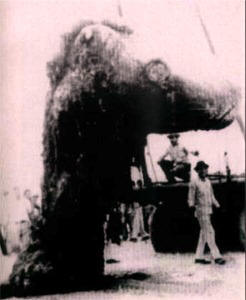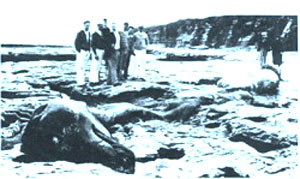|
This apparent Plesiosaur
specimen washed ashore in Monterey Bay, California in 1925. It sported a
twenty foot or so long neck and some witnesses described a number of legs on
the creature. Are Plesiosaurs still living in the Pacific Ocean?
"Click" on photos to enlarge
This approximately 50 foot long
creature washed ashore in Situate Harbor, Massachusetts during the night of
November 16, 1970
This set of pictures is of a
dead creature caught off the coast of New Zealand in 1977 by a
Japanese Fishing boat the Zuiyo Maru; 32 feet long weighing
two tons. A detailed drawing and samples were taken of the creature by a
"marine biologist" on board. He did not believe the animal to be a
decomposing basking shark as the evol/materialists currently dismiss the
find as. Below are two sites that discuss the evidence that the creature was
a plesiosaur.
For full story, "click" on
following links:
HERE and
HERE
"Click" on photos to enlarge
"Click" on photos to enlarge

Tecoluta, Mexico 1969
Thirty five tons of something
big and dead was found on the beach in Tecoluta, Mexico in
March, 1969 and whatever it was, it certainly received a great
deal of publicity. The strange carcass's serpent-like body was covered with
hard jointed armor.
A 10 foot bone tusk--estimated to weigh a ton--protruded from its head.
UPI reported that biologists thought that the creature might have
been a narwhal - which has a long tusk - but that after seeing the
carcass, "they could not match it with any sea creature known to man."
The international press reported that a prehistoric monster of some sort had
been beached and the world awaited further word on the carcass.
A seven-man commission of scientists reported on April 20, 1969 that the
monster was a rorqual whale, known as the finback whale,
however, that particular explanation fell short of explaining the 1
ton horn and body armor. Not only that, the first group of
biologists who thoroughly examined it with the idea that it might be a whale
concluded that again; it did not match any sea creature known to man.

This appears to be the head
region surrounded by dismembered cartilaginous "gill basket" supports.

One source claims that this is
part of the creatures lungs while a more moderate evaluation say it may
tissue be from the the digestive system.

This picture shows biologist
Henry De Roos, the scientist who made an autopsy on the creature. He is
holding the head with one hand, and the eye set of the optic nerve of the
creature.

This is what might be expected
of a pelvic fin ray that has been shredded by wave action.
Creature Washes Up On Nova
Scotia
"They let it go as a basking shark and the site where the creature came a
shore, was in front of a International Camp Grounds. So like all tourists,
they could see that it was NO Basking Shark, and chopped it up and
took home specimens that should have been in a museum. A SAD TIME FOR
CANADA.... A scientific team should have been established, and sent to
cover this amazing event. This is a sad time for Canada, but a worse loss
for all the world! I have put in so much time, effort, etc. to bring about
an answer. The Discovery channel will probe this angle, and I will be part
of this. I would like you to come here, and see what we have, and help make
these authorities do what is right".
A scientist who prefers to remain anonymous for the time being has this to
say:
"DFO people should know the elementary fact that
no fish has a neck
-- the pectoral fins come off the body immediately behind the head in all
fish species. The basking shark also has a relatively massive head, five
pairs of gills, and small pectoral fins. The evidence from all these photos
and your sketch does supports similarity of the carcass to the cryptozoological marine entity named and figured superficially by
Heuvelmans (1968) as the "long-necked sea-serpent".
The small pair of tube-like "horns" on the head may be
diagnostic. This large marine species has never been formally described in
the scientific literature because no specimen, or good photograph of a
specimen, existed. Now we have one. At all cost, the bits and pieces that
have been taken away, especially the head and skull which is diagnostic of
the species and higher classification categories, should be rescued and
assembled in one place."
Excerpt from a website
HERE

This is a shot of biologist
Henry De Roos standing in front of the carcass he has been dissecting,
in which the unusually large pectoral fins, in end-on view, come together at
the tips.

What's Bigger Than A Whale
and Goes: Bloop?
Scientists Mystified by Monster Sound in Deep Sea
June 13, 2002
LONDON, England -- Scientists
have revealed a mysterious recording that they say could be the sound of a
giant beast lurking in the depths of the ocean. Researchers have nicknamed
the strange unidentified sound picked up by undersea microphones "Bloop."
While it bears the varying frequency hallmark of marine animals, it is far
more powerful than the calls made by any creature known on Earth, Britain's
New Scientist reported on Thursday. It is too big for a whale and one theory
is that it is a deep sea monster, possibly a many-tentacled giant squid. In
1997, Bloop was detected by U.S. Navy "spy" sensors 3,000
miles apart that had been put there to detect the movement of Soviet
submarines, the magazine reports. The frequency of the sound meant it had to
be much louder than any recognized animal noise, including that produced by
the largest whales.
So is it a huge octopus? Although dead giant squid have been washed up on
beaches, and tell-tale sucker marks have been seen on whales, there has
never been a confirmed sighting of one of the elusive cephalopods in the
wild. The largest dead squid on record measured about 60ft including the
length of its tentacles, but no one knows how big the creatures might grow.
For years sailors have told tales of monsters of the deep including the
huge, many-tentacled kraken that could reach as high as a ship's mainmast
and sink the biggest ships.
However Phil Lobel, a marine biologist at Boston University,
Massachusetts, doubts that giant squid are the source of Bloop.
"Cephalopods have no
gas-filled sac, so they have no way to make that type of noise," he
said. "Though you can never rule anything out completely, I doubt it."
Scientists from the U.S.'s
NOAA have been baffled by the "Bloop" sound.
Nevertheless he agrees that the sound is most likely to be biological in
origin. The system picking up Bloop and other strange noises
from the deep is a military relic of the Cold War. In the 1960s the
U.S. Navy set up an array of underwater microphones, or hydrophones,
around the globe to track Soviet submarines. The network was known as
SOSUS, short for Sound Surveillance System.
The listening stations lie hundreds of yards below the ocean surface, at a
depth where sound waves become trapped in a layer of water known as the
"deep sound channel". Here temperature and pressure cause sound waves to
keep traveling without being scattered by the ocean surface or bottom. Most
of the sounds detected obviously emanate from whales, ships or earthquakes,
but some very low frequency noises have proved baffling.
Scientist Christopher Fox of the U.S. National Oceanic and
Atmospheric Administration's Acoustic Monitoring Project at Portland,
Oregon, has given the signals names such as Train, Whistle, Slowdown,
Upsweep and even Gregorian Chant.
He told New Scientist that most can be explained by ocean currents, volcanic
activity -- Upsweep was tracked to an undersea South Pacific mountain
that had not been identified as "live."
"The sound waves are almost
like voice prints. You're able to look at the characteristics of the
sound and say: 'There's a blue whale, there's a fin whale, there's a
boat, there's a humpback whale and here comes and earthquake," he says.
But some sounds remain a mystery
he says. Like Bloop -- monster of the deep? Listen to
Bloop here:
The Deep Sounds of Bloop
|

















